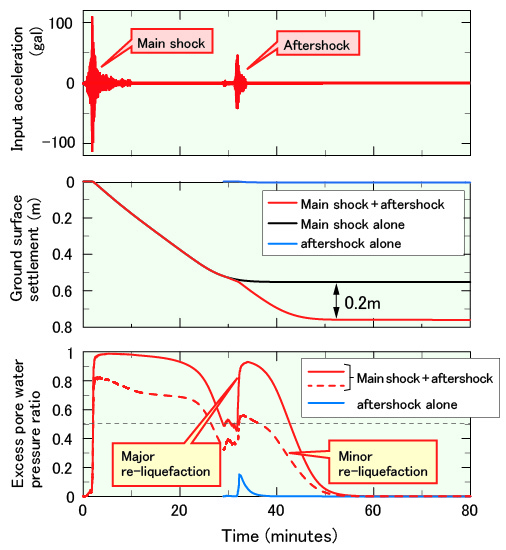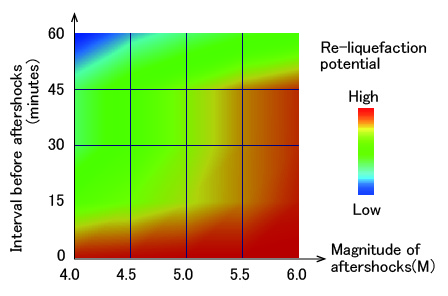3. Method for predicting the deformation of liquefiable ground considering the influence of aftershocks
- A method was developed to predict the deformation of liquefiable ground taking into account the influence of aftershocks.
- In case of a massive earthquake and aftershock clusters, this method makes it possible to evaluate the potential of re-liquefaction depending on the degree of liquefaction during the main shock, intervals between the main shock and aftershocks and the magnitude of aftershocks.
When liquefaction occurs following an earthquake, there is a possibility that areas of ground can suffer subsidence as a result of the build-up and dissipation of pore water pressure. When the Tohoku Region Pacific Coast Earthquake struck in the Urayasu district of Chiba Prefecture aftershocks occurred before water pressure had fully dispersed finally causing subsidence of up to 0.8m. In traditional calculations for liquefaction, subsidence due to water pressure dissipation and re-liquefaction from aftershocks are not taken into account. Consequently (Upper part of Fig 1)a method was developed which takes into account not only increase in water pressure, but also the dissipation process, in order to make it possible to estimate the magnitude of ground deformation due to liquefaction considering the influence of aftershocks in case of a massive earthquake.
Results from an analysis of the application of this method to the Urayasu district revealed that there was no subsidence following liquefaction in the case where the area was not exposed to the main shock, but just subjected to an earthquake the size of an aftershock. (Middle of Fig 1). Whereas when the same area was subjected to the aftershock after first being exposed to the main shock, as a result of re-liquefaction subsidence finally occurred and exceeded that computed after the main shock alone. Moreover, the estimated value was consistent with the measured subsidence(of approximately 0.8m)(Middle of Fig 1). It was found that the combination of the main shock and aftershocks on this occasion resulted in initial liquefaction after the first main shock. Moreover, if the excess pore water pressure ratio (indicator showing scale of liquefaction, a score of 1.0 equals total liquefaction)exceeded 0.5, then the probability of re-liquefaction following an aftershock increased. (Lower part of Fig 1).
Furthermore, this method will also make it possible to estimate the influence of time intervals and magnitude of aftershocks on the probability of re-liquefaction (Fig 2). The combination of this method with another developed for estimating the time series, including aftershocks, of earthquake clusters, makes it possible to evaluate the potential for re-liquefaction depending on the degree of liquefaction during the main shock and intervals between the main shock and aftershocks, and the magnitude of aftershocks.

Fig.1 Analysis taking into account aftershocks
Fig.2 Re-liquefaction potential under aftershocks
(with a main shock magnitude of 7)